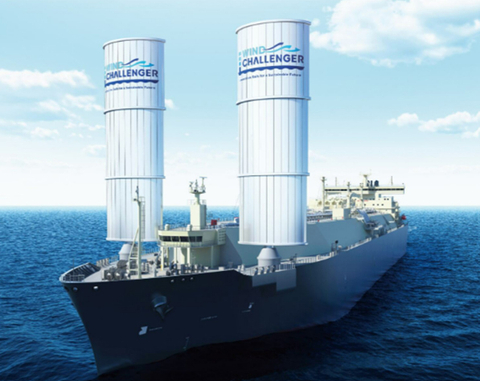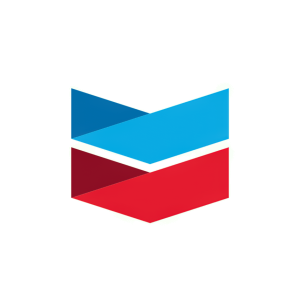Chevron Shipping Company and MOL to Install Wind Challenger on LNG Carrier
Wind-Assisted Ship Propulsion System is an LNG Shipping First

The Wind Challenger equipped LNG carrier (Photo: Business Wire)
The vessel is under construction at the Geoje Shipyard of Hanwha Ocean Co., Ltd. and is scheduled for delivery in 2026. In August 2024, MOL obtained an approval in principle (AiP) by Nippon Kaiji Kyokai (Class NK) – a first for an LNG carrier with a Wind-Assisted Ship Propulsion System (Note 2). The Chevron chartered vessel will be the first application.
Wind Challenger will help reduce fuel consumption and GHG emissions by using its unique telescopic sails.
In addition to the robust design of Wind Challenger itself, additional safety measures include a fully enclosed navigation bridge and a lookout station on the vessel’s fore deck to further enhance visibility.
For tradability, the installation position of the Wind Challenger aims to minimize impact on the existing design of membrane type LNG Carriers. It will enable the retention of the existing mooring arrangement unchanged and thereby minimize impacts on ship shore compatibility, together with limited impact on the vessel’s windage area.
“We’re proud to partner with MOL in Wind Challenger’s industry-first LNG installation,” said Barbara Pickering, President of Chevron Shipping Company. “This is another example of using novel approaches in hard-to-abate sectors to reduce carbon intensity in our LNG fleet.”
Takeshi Hashimoto, President, and CEO of Mitsui O.S.K. Lines, said, “With the understanding and cooperation of Chevron, we are delighted to be able to expand the Wind Challenger Project to LNG carriers in addition to the two delivered Wind Challenger-equipped bulkers (Note 3) and other ongoing projects (Note 4). Achieving GHG reduction in the maritime transport of LNG, which is increasingly in demand worldwide as a transition fuel, is a very important mission for us. This project will undoubtedly be a significant milestone towards achieving 'net-zero emissions by 2050', a medium to long-term goal of the Mitsui O.S.K. Lines Group, as stated in our 'Environmental Vision 2.2'.”
The Wind Challenger technology will be on exhibit at the MOL booth at the Gastech Exhibition & Conference 2024 in
<Vessel Outline>
Ship Owner
|
MOL Encean Pte. Ltd. |
LOA / Breadth
|
About 286 m / About 46 m |
Cargo Tank Capacity
|
About 174,000 m3 |
Shipyard
|
Hanwha Ocean Co., Ltd. |
Wind Challenger Specifications |
Number of Sail: 2 Height: Up to 49 m (3-tier) Width: About 15 m Sail material: Fiber Reinforced Plastic |
(Note 1) For details, please refer to the following web site.
Wind Challenger: The Wind Assisted Ship Propulsion System | SERVICES | Mitsui O.S.K. Lines, Ltd. Solutions (mol-service.com)
(Note 2) For details, please refer to the following press release.
MOL Obtains AiP for "LNG Carrier Installing Wind Challenger" - The World's First Approval for an LNG Carrier - | Mitsui O.S.K. Lines
(Note 3) For details, please refer to the following press releases.
Delivery of SHOFU MARU, World's First Cargo Vessel equipped with 'Wind Challenger' Hard Sail | Mitsui O.S.K. Lines
MOL Announces Delivery of Bulk Carrier Green Winds, 2nd Vessel Equipped with Wind Challenger Hard Sail Propulsion System | Mitsui O.S.K. Lines
(Note 4) For details, please refer to the following press releases.
Wind Challenger to be Installed on Coal Carrier for J-Power - World's 1st Retrofit on an In-service Vessel - | Mitsui O.S.K. Lines
Wind Propulsion Systems will be Installed on 7 Vessels Operated by MOL Drybulk - Steadily Pursuing to '25 Wind Challenger-equipped Vessels' by 2030 - | Mitsui O.S.K. Lines
About Chevron:
Chevron is one of the world’s leading integrated energy companies. We believe affordable, reliable and ever cleaner energy is essential to enabling human progress. Chevron produces crude oil and natural gas; manufactures transportation fuels, lubricants, petrochemicals and additives; and develops technologies that enhance our business and the industry. We aim to grow our oil and gas business, lower the carbon intensity of our operations and grow lower carbon businesses in renewable fuels, carbon capture and offsets, hydrogen and other emerging technologies. More information about Chevron is available at www.chevron.com.
About MOL:
MOL is a leading shipping company, operating on a global scale with more than 800 vessels in service. The company develops various social infrastructure businesses centered on ocean shipping, as well as technologies and services to meet ever-changing social needs including environmental protection. The MOL fleet includes dry cargo ships, liquefied natural gas (LNG) carriers, car carriers, and tankers. In addition to the traditional shipping businesses, MOL also offers wellbeing & lifestyle businesses such as real property, terminal operation, and ferry service, as well as social infrastructure businesses such as logistics and offshore wind power. With one of the largest merchant fleets and about 140 years of history, experience, and technology, MOL will make a leap forward to become a global social infrastructure company, support people's daily lives from the blue ocean, open the way to a prosperous future, and deliver new value to all stakeholders.
Website: https://www.mol.co.jp/en/
CAUTIONARY STATEMENTS RELEVANT TO FORWARD-LOOKING INFORMATION FOR THE PURPOSE OF “SAFE HARBOR” PROVISIONS OF THE PRIVATE SECURITIES LITIGATION REFORM ACT OF 1995
This news release contains forward-looking statements relating to Chevron’s operations and lower carbon strategy that are based on management’s current expectations, estimates, and projections about the petroleum, chemicals and other energy-related industries. Words or phrases such as “anticipates,” “expects,” “intends,” “plans,” “targets,” “advances,” “commits,” “drives,” “aims,” “forecasts,” “projects,” “believes,” “approaches,” “seeks,” “schedules,” “estimates,” “positions,” “pursues,” “progress,” “may,” “can,” “could,” “should,” “will,” “budgets,” “outlook,” “trends,” “guidance,” “focus,” “on track,” “goals,” “objectives,” “strategies,” “opportunities,” “poised,” “potential,” “ambitions,” “aspires” and similar expressions, and variations or negatives of these words, are intended to identify such forward-looking statements, but not all forward-looking statements include such words. These statements are not guarantees of future performance and are subject to numerous risks, uncertainties and other factors, many of which are beyond the company’s control and are difficult to predict. Therefore, actual outcomes and results may differ materially from what is expressed or forecasted in such forward-looking statements. The reader should not place undue reliance on these forward-looking statements, which speak only as of the date of this news release. Unless legally required, Chevron undertakes no obligation to update publicly any forward-looking statements, whether as a result of new information, future events or otherwise.
Among the important factors that could cause actual results to differ materially from those in the forward-looking statements are: changing crude oil and natural gas prices and demand for the company’s products, and production curtailments due to market conditions; crude oil production quotas or other actions that might be imposed by the Organization of Petroleum Exporting Countries and other producing countries; technological advancements; changes to government policies in the countries in which the company operates; public health crises, such as pandemics and epidemics, and any related government policies and actions; disruptions in the company’s global supply chain, including supply chain constraints and escalation of the cost of goods and services; changing economic, regulatory and political environments in the various countries in which the company operates; general domestic and international economic, market and political conditions, including the military conflict between
View source version on businesswire.com: https://www.businesswire.com/news/home/20240913468521/en/
Christine Dobbyn
External Affairs Advisor, Chevron
Tel: +1 281-906-1499
christinedobbyn@chevron.com
Mitsui O.S.K. Lines, Ltd.
Corporate Communications Division, Media Relations Team
E-mail: mrtmo@molgroup.com/TEL: 03-3587-7015
Source: Chevron Corporation







